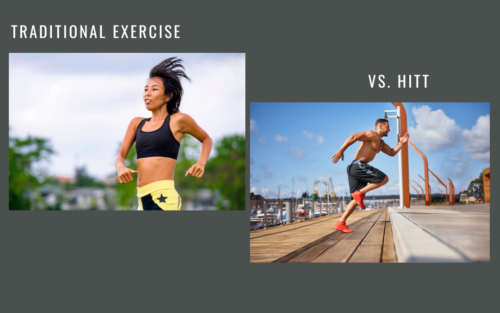High-intensity interval training, or HIIT, has gained popularity in recent years as a time-efficient and effective way to improve overall health and aid in weight loss. This form of exercise involves short bursts of intense activity followed by a period of rest or low-intensity exercise, being able to be tailored to meet individual fitness levels and preferences. Read on to learn everything you need to know about the benefits of HIIT for fat loss and health in this comprehensive guide.
Understanding High-Intensity Interval Training
High-Intensity Interval Training (HIIT) is a form of exercise that involves short intervals of intense activity followed by periods of rest or low-intensity exercise. The focus of this exercise protocol is to enable individuals to perform a challenging workout without spending as much time doing so. The goal of HIIT is to push the body to its limits for short bursts, leading to more efficient and effective workouts.
It’s worth noting that HIIT offers numerous health benefits for a wide range of individuals. These benefits include calorie burn, reduced body fat, improved heart rate and blood pressure, and even better blood sugar regulation.
The versatility of HIIT also allows individuals to incorporate it into various fitness routines, including overall carotid or bodybuilding, making it an accessible and beneficial addition to any exercise regimen.
Key Elements of HIIT
There are three primary components of a successful HIIT workout:
- Intensity: During the intense intervals, it’s crucial to push yourself to give maximum effort. This level of intensity will vary based on the individual, but it should feel challenging and taxing on the body.
- Duration: Understanding the length of both the high-intensity intervals and the rest periods is crucial in HIIT workouts. It’s essential to find the right balance between the two to ensure that the workout is challenging but also sustainable. The duration of these intervals can range from a few seconds to a few minutes, depending on the exercise and the individual’s fitness level.
- Recovery: Adequate recovery is an essential component of HIIT, as it allows the body to recuperate and prepare for the next high-intensity interval. Recovery can take the form of complete rest or low-intensity exercise, such as jogging or walking.
Benefits of HIIT
The appeal of HIIT lies in its ability to deliver numerous benefits, including burning calories, reducing body fat, and improving cardiovascular fitness. One of the key benefits of HIIT is its ability to burn a significant number of calories in a short amount of time compared to traditional workouts. This contributes to weight loss by helping individuals create a calorie deficit, which is necessary for shedding pounds. In addition, studies have shown that HIIT may be more effective at reducing body fat than steadier forms of exercise, such as jogging.
HIIT for Fat Loss
High-intensity interval training (HIIT) is an excellent way to burn calories more effectively in a relatively short amount of time. This type of exercise alternates between periods of intense activity and periods of less intense activity or rest.
Effective Fat Loss
By engaging in these short bursts of high-intensity exercise, your body burns more calories than it would with a traditional steady-state cardiovascular workout. Research has shown that HIIT may provide the same health benefits as regular exercise but in less time. HIIT workouts are also known for inducing the “afterburn effect” or Excess Post-ExerciseOxygen Consumption (EPOC), which means that your body continues to burn calories at a higher rate, even after the workout is finished. As a result, HIIT can significantly contribute to weight loss while also improving cardiovascular health.
Increasing Metabolic Rate
Another major advantage of HIIT is its ability to increase your metabolic rate. By incorporating high-intensity exercises into your workout routines, you can boost your body’s ability to burn calories both during and after exercise. This increase in metabolism helps to reduce body fat, lower LDL cholesterol, and improve overall well-being. Studies suggest that working out at a high intensity can increase your resting metabolic rate for up to 48 hours after a HIIT session.
Muscle Mass
An added benefit of HIIT is that it enables you to build muscle while burning fat. It positively affects your skeletal muscle at the cellular level. Increased muscle mass naturally leads to an increased metabolic rate, further enhancing the calorie-burning potential of your workouts. This also has a powerful antiaging benefit. By combining HIIT workouts with a healthy diet, you can effectively optimize your weight loss efforts and enjoy the numerous health benefits associated with this style of training.
HIIT for Health
Beyond fat loss, HIIT has multiple health benefits. Studies show associations between HIIT and improvements in cardiometabolic health, lower LDL cholesterol levels, better blood sugar regulation, and enhanced mental well-being.
Improving Cardiovascular Health
HIIT workouts can provide several benefits to your cardiovascular health. Research indicates that these high-intensity workouts can help reduce heart rate and blood pressure. By pushing your heart and circulatory system to work harder during intervals, HIIT can lead to improved cardiovascular endurance and overall heart health.
Enhancing Lung Capacity
Another benefit of HIIT is its ability to increase lung capacity. During high-intensity intervals, your body requires more oxygen to fuel your muscles, leading to an increased demand on the respiratory system. Over time, this can improve your lung’s ability to take in and utilize oxygen, making daily activities and exercise easier and more efficient.
Promoting Mental Health
Lastly, there’s evidence that HIIT can have a positive impact on mental health. Regular participation in high-intensity workouts has been linked to improved mental health and memory. These short yet intense sessions can help boost mood and reduce stress, contributing to overall well-being. The mental benefits of HIIT may be attributed to the release of endorphins and other feel-good hormones that occur during and after exercise.
HIIT Compared to Traditional Workouts

Efficiency of Time Investment
High-intensity interval training has become a popular alternative to traditional workouts due to its efficiency in time investment. HIIT allows for an effective workout in a shorter time compared to steady-state cardio exercises like jogging. Studies show that HIIT can burn a significant amount of calories in a short period, making it an attractive option for individuals with busy schedules.
Plus, as mentioned above, the afterburn effect can lead to greater calorie expenditure following a HIIT workout. This makes HIIT an efficient choice for those looking to improve their fitness and lose weight while minimizing their time investment.
Cost Effectiveness & Versatility
Another advantage of HIIT workouts is their cost-effectiveness. Traditional workouts, especially in gym settings, can sometimes require costly equipment or memberships. On the other hand, many HIIT exercises can be performed with little or no equipment at all, making them more accessible and affordable. Many cost-effective HIIT exercises are bodyweight exercises performed at high-intensity intervals.
Additionally, the versatility of HIIT workouts allows individuals to integrate various types of exercises based on personal preferences and fitness goals, further enhancing their cost-effectiveness.
Guide to Incorporating HIIT
Establishing a Workout Routine
To begin a HIIT workout routine, it is essential to determine the length and intensity of each interval. Since a HIIT workout consists of alternating periods of high-intensity exercise followed by periods of low-intensity recovery, one might perform an exercise at maximum effort for 30 seconds, followed by a 60-second recovery period at a lower effort. The entire workout should last between 20-30minutes, including warm-up and cool-down.
When starting a HIIT routine, it is crucial to consider individual fitness levels. Beginners should begin with shorter high-intensity intervals, gradually increasing their duration over time. It is also important to gradually increase the intensity to prevent injury and maintain motivation. You can incorporate HIIT workouts into your routine two to three times per week, allowing adequate recovery time between sessions. Your body will need time to adapt to the increased intensity and recover properly.
Choosing the Right Exercises
Select exercises that target multiple muscle groups and elevate the heart rate. Some popular HIIT exercises include sprints, burpees, squats, mountain climbers, push-ups, jumping jacks, and high knees. There is no one-size-fits-all approach to HIIT, so choose exercises that align with your fitness level and goals.
To prevent boredom and maximize benefits, it is important to vary the exercises used in each session. This will not only keep the workouts engaging but also ensure a well-rounded and balanced fitness routine.
When planning your workout, be sure to include a proper warm-up and cool-down. Warm-ups should consist of dynamic stretches and/or low-intensity aerobic exercise, while cool-downs should focus on static stretching and reducing heart rate to baseline levels. In conclusion, starting a HIIT routine involves establishing a workout routine with the right interval lengths and intensity and choosing exercises that suit the individual’s fitness level and goals. By combining these elements, it is possible to create a HIIT program that is both effective and enjoyable.
Precautions and Considerations
Before diving into a HIIT program, there are certain aspects to consider. It’s vital to be aware of these cautions to avoid complications and maximize benefits. High-intensity interval Training can be demanding on the body, increasing the risk of injury if not executed correctly.
To minimize this risk, follow these guidelines:
- Make sure you warm up and cool down properly to prepare your muscles and joints for the intense exercises.
- Focus on proper form to ensure the effectiveness of each exercise and decrease the likelihood of injury.
- Gradually increase the intensity and duration of your HIIT workouts to avoid overexertion and allow your body to adapt.
- Listen to your body. If you feel pain or discomfort, stop immediately.
- Consider working with a certified personal trainer or fitness expert to ensure that the exercises are tailored to your fitness level and goals.
Dealing with Health Conditions
Individuals with certain health conditions should consult their healthcare provider before engaging in HIIT. Some conditions to be cautious of include:
- Cardiovascular diseases: Individuals with heart-related conditions should obtain
clearance from their doctor to ensure that high-intensity exercise is safe for them. - Joint-related issues: HIIT can put stress on joints, particularly in the knees and hips. If you have arthritis or other joint problems, consult your healthcare provider for guidance on suitable exercises.
- Diabetes: While HIIT can improve blood sugar control, it can also cause fluctuations in blood glucose levels. Individuals with diabetes should be cautious and monitor their levels closely during and after workouts.
- Asthma: Intense workouts can trigger asthma symptoms, so ensure you have your
inhaler or necessary medications on hand during HIIT sessions.
Remember, always consult with a healthcare professional before starting any new exercise program, especially if you have pre-existing health conditions. Adapt HIIT workouts to your personal needs and limitations to experience optimal benefits and avoid health complications.
HIIT is a time-efficient and cost-effective exercise protocol that combines high-intensity intervals with periods of rest or low-intensity exercise. HIIT has numerous benefits such as helping you to lose body fat, improve cardiovascular health, enhance lung capacity, and promote mental well-being. Incorporate the principles highlighted in this guide to incorporate HIIT into your routine and experience impressive results in a shorter amount of time.
To a Fitter Healthier You,
The Fitness Wellness Mentor



